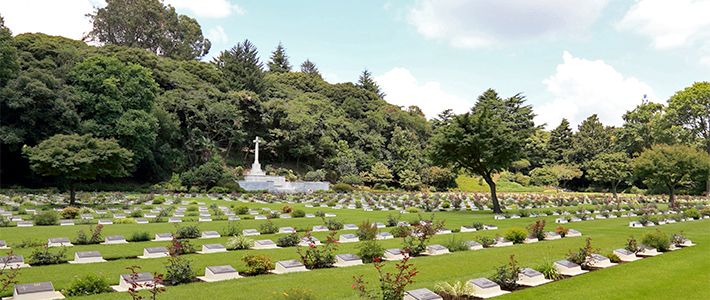
Honoring Enemy POWs: A Grassroots Initiative
Society- English
- 日本語
- 简体字
- 繁體字
- Français
- Español
- العربية
- Русский
A crowd of people bow their heads in mourning as the midsummer sun beats down on the glistening lawn, the cries of cicadas in the surrounding trees piercing the silence.
It was August 6, 2016, the anniversary of the dropping of the atomic bomb on Hiroshima. But at the Yokohama War Cemetery in the city’s Hodogaya Ward, people had gathered to honor another legacy of World War II: the Commonwealth soldiers who died in Japan as prisoners of war. The memorial service is held each year on the first Saturday in August at 11 am, and this year’s event was the twenty-second to date.
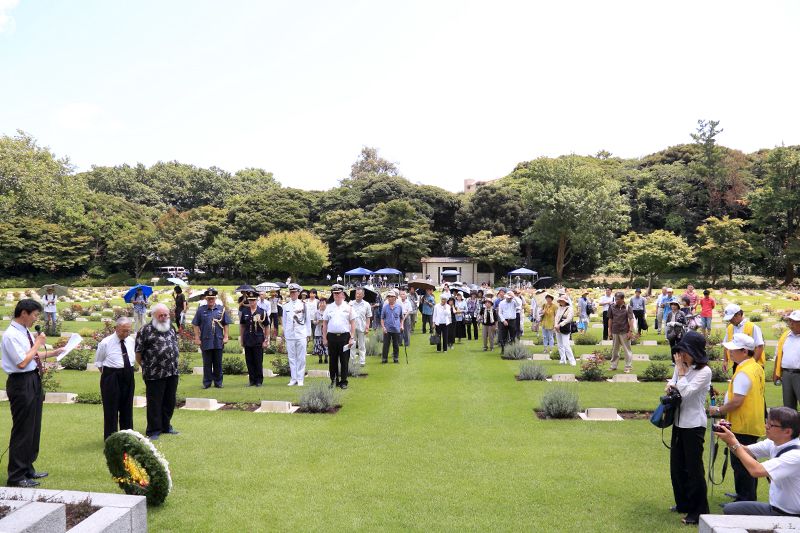 There were 110 participants at this year’s service.
There were 110 participants at this year’s service.
Remembering the War Dead
The ceremony began with remarks by Sekita Hiroo, a pastor with the United Church of Christ in Japan who has attended every memorial service held to date. Referring to the visit to Hiroshima by US President Barack Obama in May, he invited all guests to work together toward a world free of nuclear weapons and marked by peaceful coexistence. Next to speak was Canadian Defence Attache Captain (RCN) Chris Dickinson of the Canadian Embassy in Tokyo, who noted that if reconciliation is possible among soldiers who fought against one another, then it can certainly be achieved among other individuals and between nations. The participants listened attentively to the many other speeches that followed before singing hymns and making flower offerings to the war dead.
Each gravestone, placed at even intervals, carries a plate identifying the deceased, such as that of a British soldier who died on March 17, 1945, at age 24. It is for these wartime casualties, many of whom were prisoners of war, that the participants offer their prayers.
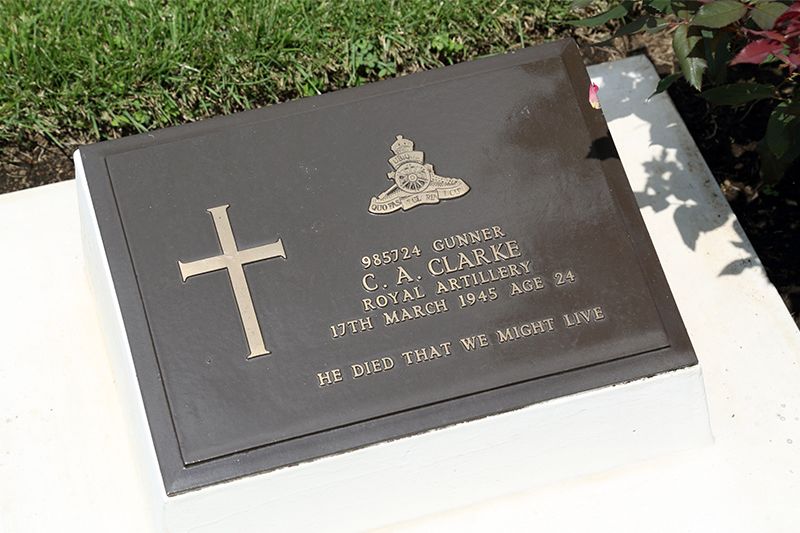 Approximately 1,700 gravestones are spread out over the 8-acre war cemetery.
Approximately 1,700 gravestones are spread out over the 8-acre war cemetery.
A Grassroots Initiative
The Yokohama War Cemetery is maintained by the British-based Commonwealth War Graves Commission (CWGC), which cares for 23,000 cemeteries, memorials, and other locations in 154 countries that are the final resting place for 1.7 million Commonwealth soldiers who died in World War I and II. These sites are of great importance to the Commonwealth, and Yokohama is no exception. Many dignitaries from Commonwealth countries pay their respects at the cemetery when visiting Japan, Queen Elizabeth being among them.
Ceremonies organized by Commonwealth or host governments are held throughout the year at CWGC locations worldwide. Yokohama is the only site, though, where the services are organized by private citizens. There is one family member of a former Allied POW who, moved by this grassroots initiative, always attended the service while being stationed in Japan. Many local residents also participated this year, including 19-year-old Morii Motoki,a student at a yobikō (for high school graduates preparing to retake a college entrance exam) who helped lay a wreath during the ceremony. He learned about the service last year from his high school teacher, and this year came on his own with friends. “I’d like to spread the word about this important ceremony,” Morii said.
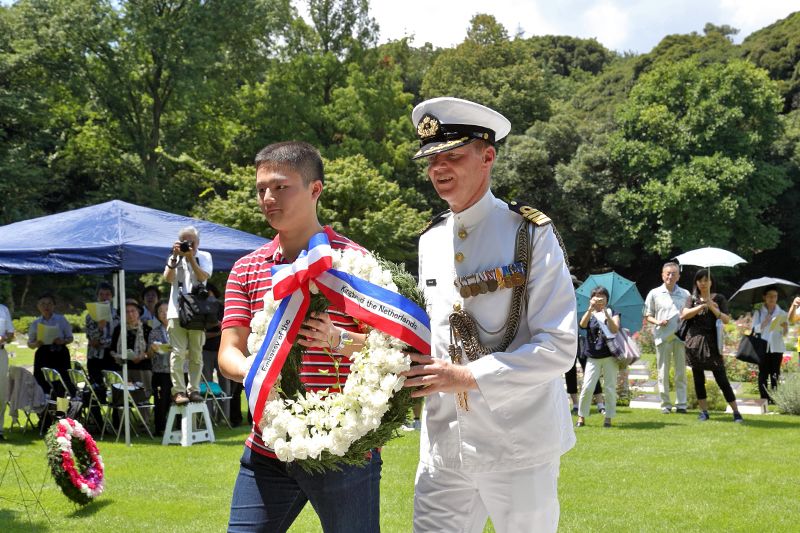 Morii Motoki, left, helps lay a wreath as other participants sing “Home, Sweet Home.”
Morii Motoki, left, helps lay a wreath as other participants sing “Home, Sweet Home.”
Keeping Memories Alive
The service in Yokohama was launched in 1995, the fiftieth anniversary of the end of World War II, by three Japanese citizens: the late Nagase Takashi, a former member of the Kenpeitai (military police) who served as an interpreter during construction of the Thailand-Burma Railway;(*1)) the late International Christian University professor emeritus Saitō Kazuaki; and Aoyama Gakuin University professor emeritus Amemiya Tsuyoshi. Nagase and Saitō met when they were working on a Japanese translation of the Miracle on the River Kwai by Earnest Gordon, who worked on the railroad as a prisoner of war, while Amemiya was introduced to Saitō by Nagase. In the statement explaining the reasons for launching the memorial service, the three men proclaim their resolve to squarely face the history of Japanese wartime brutalities, such as the Bataan Death March,(*2)) committed against Allied POWs and to chart a path to peace by keeping these memories alive.
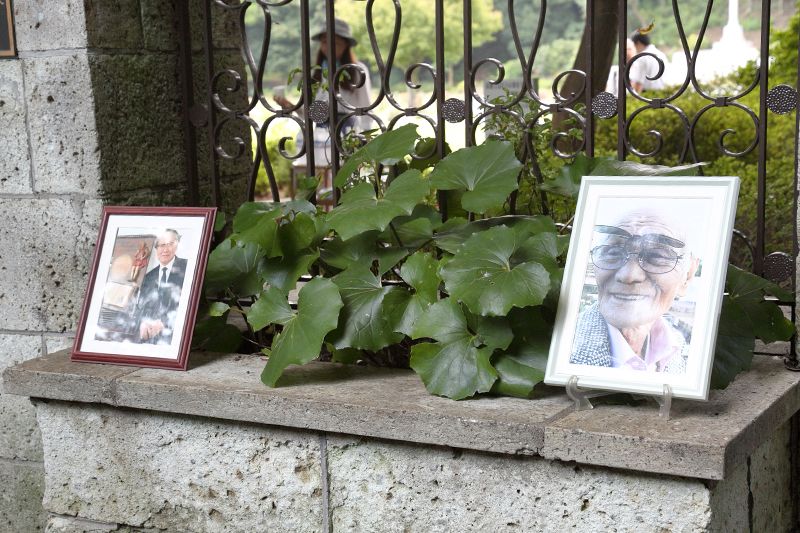 Photos of Saitō (left) and Nagase (right), now deceased, were placed at the war cemetery during the memorial service.
Photos of Saitō (left) and Nagase (right), now deceased, were placed at the war cemetery during the memorial service.
War Crimes against POWs
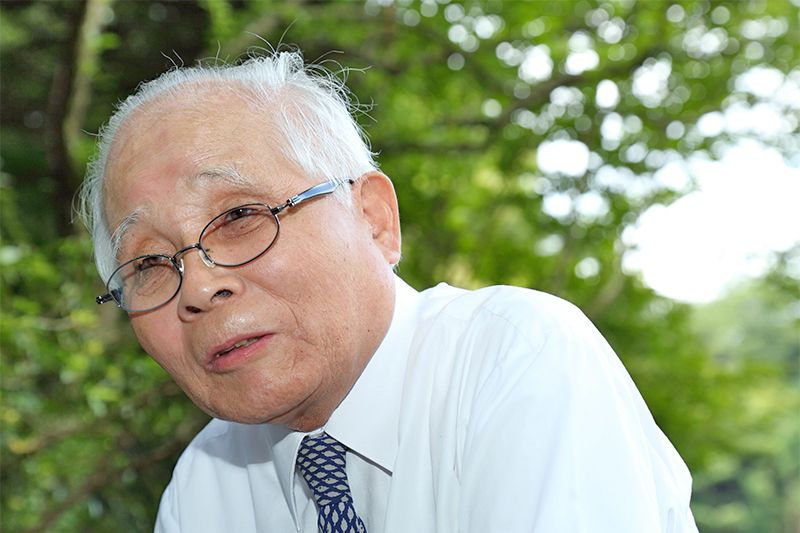 Amemiya Tsuyoshi is grateful for the opportunity to meet directly with former POWs, saying, “I’m terribly sorry about what they’ve suffered, but I’m also very happy that they’ve taken the trouble to attend. It’s a first step toward forgiveness, and we need more opportunities for exchange.”
Amemiya Tsuyoshi is grateful for the opportunity to meet directly with former POWs, saying, “I’m terribly sorry about what they’ve suffered, but I’m also very happy that they’ve taken the trouble to attend. It’s a first step toward forgiveness, and we need more opportunities for exchange.”
“Prisoners of war are people who have laid down their arms,” explains Amemiya of the reasons for launching the memorial service. “The Japanese Army wound up killing many Allied POWs, though, through forced labor, physical abuse, and starvation. Had Japan abided by the terms of international conventions on the treatment of POWs, the prisoners would have received sufficient food and water, not have been forced to undertake hard labor, and could have returned home to their loved ones. I think the Japanese military committed a grave crime.” Amemiya was still a schoolboy, thoroughly indoctrinated in the glories of militarism, when the war ended. “My life over the seventy years since then has been a continuous effort to extricate myself of this indoctrination.” Believing the atomic bombings of Hiroshima and Nagasaki, too, to be war crimes, he notes that atrocities were committed by both sides, not by Japan alone. But that does not, he emphasizes, exonerate Japan from the need to atone for its actions.
Supported by Volunteers
A Christian service is held, out of respect for the fact that many of the POWs were of that faith, but participation is not limited to Christians. The ceremony is supported mainly by volunteers who responded to an appeal for help in organizing the annual event attended by over 100 people each year.
The cemetery consists of four zones for servicemen from Britain, Australia, Canada–New Zealand, and India-Pakistan. The main ceremony is held in the British section, which is the largest, but participants also visit the three other sections as well as an urn containing the ashes of Allied POWs. As wreaths are laid, participants sing songs associated with each country. Videos and lyrics of the songs are uploaded on a social media site so participants can practice before attending. The song for the Australian section this year was “Waltzing Matilda,” perhaps the country’s best-known folk ballad.
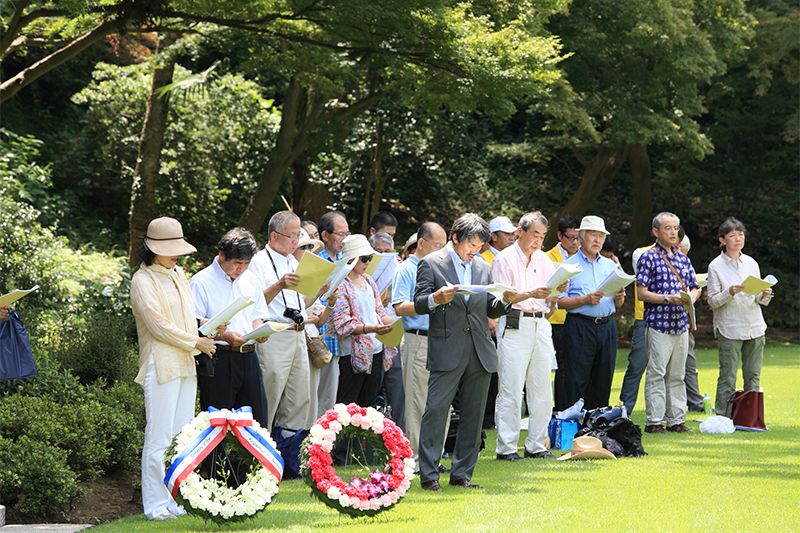 Participants sing in remembrance of each country’s POWs.
Participants sing in remembrance of each country’s POWs.
Remembering POWs’ Hardship
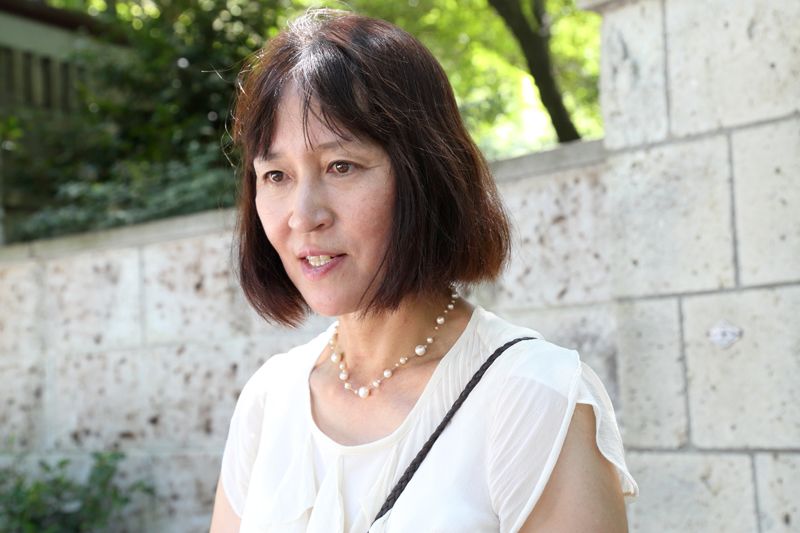 Saitō Naoko hopes that subsequent generations will continue the memorial service. “My 25-year-old son is beginning to realize that it’s an important event launched by his grandfather.”
Saitō Naoko hopes that subsequent generations will continue the memorial service. “My 25-year-old son is beginning to realize that it’s an important event launched by his grandfather.”
The ceremony lasts about an hour. Ever since a participant fell ill and had to be taken by ambulance to a hospital, most events have been held in the shade. Still, standing in the midsummer heat for so long can by physically taxing, especially for seniors. The organizers have thus set up corners where beverages are provided and encourage participants to drink plenty of water. There are no plans to move the date, however, as one of the aims of the memorial service is to be one with the POWs who toiled under hot, thirsty conditions.
“My father, I’ve been told, used to say that the heat was the best way of empathizing with the hardship of the POWs,” comments Saitō Naoko, daughter of the event’s co-founder Saitō Kazuaki and now a member of the organizing committee. “Being forced into hard labor in the tropics far away from home, without clothes or shoes, defies the imagination. It’s something we all need to share, at least in spirit, and for that reason I was initially even against the idea of offering water to participants during the ceremony.”
A New Generation of Stewards
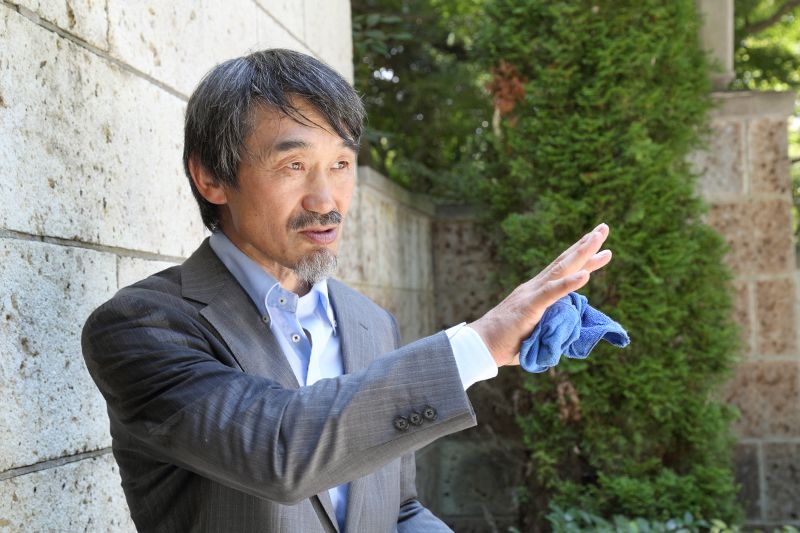 Kobayashi Kengo has been a CWGC manager since 2000 and regards the care of the graves and memorials in Yokohama as a personal mission.
Kobayashi Kengo has been a CWGC manager since 2000 and regards the care of the graves and memorials in Yokohama as a personal mission.
The Japan manager of the Commonwealth War Graves Commission, which maintains the Yokohama War Cemetery, is Kobayashi Kengo, who has attended the service each year. Having visited Kanchanaburi, the Thai province where the Thailand-Burma Railway crosses the River Kwai, Kobayashi noted—wiping the sweat from his brow—that he and others of his generation “have a responsibility for the treatment of POWs, even though we weren’t personally involved in the war.”
The annual memorial service was launched by three Japanese citizens more than 20 years ago in 1995, and it is now carried on by a new generation of organizing committee members. In addressing the participants, pastor Okutsu Takao, who heads the committee today, noted that the road to peace and reconciliation may be arduous when traversed alone, “But we can surely reach our cherished goal if we all walk the path together.”
“Crimes committed during wartime are not easily forgiven,” reflected Amemiya as the seventy-first anniversary of the end of World War II approached. “The least we can do is to continue offering our heartfelt apology through ceremonies like this one, even after those who experienced the war firsthand have long passed away. That’s why it’s so important that this service, launched through a grassroots initiative, continues for 100 or even 200 more years.”
(Originally written in Japanese by Masuda Miki and published on September 8, 2016. Photographs by Hanai Tomoko. Banner photo: The Yokohama War Cemetery in Hodogaya Ward contains over 1,500 Commonwealth burials and commemorations of World War II.)
(*1) ^ A 415-kilometer railway between Nong Pla Duk, Thailand, and Thanbyuzayat, Burma (now Myanmar), built by the Imperial Japanese Army toward the end of World War II to support its invasion of India. Construction began in July 1942 and was completed in October the following year. Forced labor was used, including some 68,000 British and other Allied POWs and 200,000 to 300,000 Southeast Asian civilian laborers, of whom 13,000 Allied POWs and possibly as many as half of the local workers died due to exhaustion, malnutrition, maltreatment, and such diseases as malaria and cholera. As chronicled in the Bridge on the River Kwai, working conditions were so harsh that “One man died for every sleeper laid.” Of all the Japanese Army’s brutalities during the war, the treatment of workers during the railway’s construction is considered the most atrocious, prompting the line to be called the “Railroad of Death.” (Information based on a statement issued by the organizers in 2008.
(*2) ^ The Battle of Bataan ended with the surrender of the US Army Forces in the Far East on April 9, 1942. The Japanese Army forced 70,000 battle-weary Filipino and 10,000 American POWs, along with 40,000 civilians, to walk 100 kilometers from Mariveles at the tip of the Bataan Peninsula enclosing Manila Bay to San Fernando, Pampanga, and then loaded the prisoners onto freight trains to Capas, Tarlac, and again marched them for 12 kilometers to Camp O’Donnell, where the POWs were housed. The prisoners received little food or water, leading to the deaths of 1,600 Americans and 29,180 Filipinos. The march was considered the most abusive in military history. (Same source as note 1.